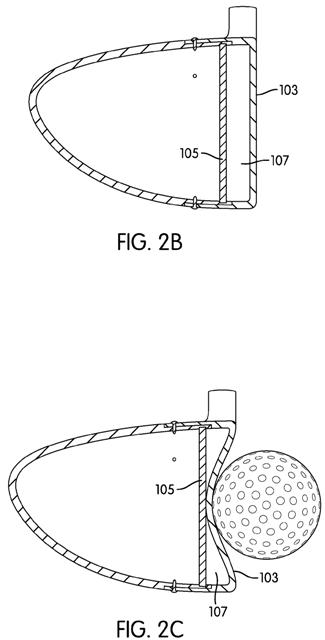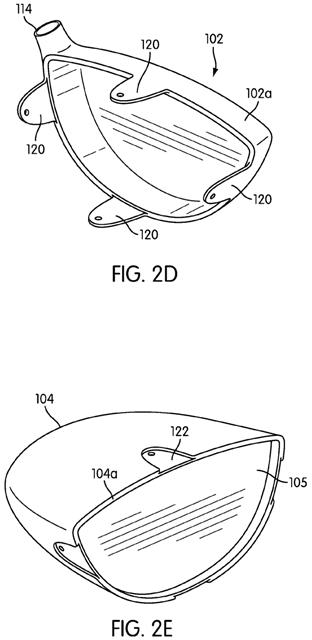How Does a Golf Club Designer Give a Slow Swing Speed Golfer the most “Spring-Like” Effect While Not Providing Too Much of a Benefit for a Fast Swing Speed Golfer?
Nike Golf thinks they may have the answer, a double wall system. A recently published Nike patent application (US Pub. No. Therefore, aspects of this disclosure relate to the double wall structure described above which allows a golf club head to have a ball striking face that provides a high COR (in some cases higher than 0.830), even when swung at slow speeds. In other words, the ball striking face can be made so that is highly flexible and resilient (e.g., more flexible and resilient than a conventional golf club head face that would provide a COR of 0.83 when swung at 160 ft/sec). For example, the ball striking face may be “ultra” thin (e.g., thinner than conventional ball striking faces that provide a COR or 0.83). With the ball striking face being more flexible, deformable, resilient, etc., the golf ball will not lose as much energy at impact and, therefore, the value of the COR of the ball striking face will be increased. As a result, the velocity of the golf ball at impact will be increased and the golf ball will carry farther. As mentioned above, such a ball striking face could provide a COR of 0.83 or higher when swung at typical amateur speeds (e.g., 140 ft/sec).
[0047] However, in order to prevent such a ball striking face from breaking the USGA’s COR limit of 0.83 when it is swung at 160 ft/sec., the second wall portion 105 is positioned close enough to the ball striking face 103 to halt the deflection/deformation of the ball striking face 103 and, thereby, limit the maximum obtainable COR if the golf club head is swung at 160 ft/sec or faster. In other words, if such a club is swung at a slow speed, then the deflection of the club face will not be halted by the second wall 105 and, hence, the COR can be as high as the characteristics of the ball striking face 103 (e.g., the dimensions of the ball striking face, such as the thickness; the material used to the make ball striking face, etc.) will allow. On the other hand, if the club is swung at a high speed, the positioning of second wall 105 ensures that the ball striking face cannot deflect fully (i.e., deflect as much as the characteristics of the ball striking face (e.g., the dimensions of the ball striking face, such as the thickness; the material used to the make ball striking face, etc.) will allow) and, hence, cannot achieve the full COR that the characteristics of the ball striking face would have provided. Thereby, the second wall 105 is positioned from the ball striking face 103, based on the characteristics of the ball striking face such that only a maximum COR value of 0.83 is obtainable if the golf club head is swung at 160 ft/sec or faster. Therefore, it is appreciated that the double wall structure allows slow swing speed golfers to achieve the same (or even greater) amount of “trampoline” or “spring-like” effect from the ball striking face 103 as high speed golfers and, hence, slow swing speed golfers are not “penalized” by the USGA’s rules regarding COR.
[0048] In view of the above discussion, it is understood that it would be advantageous for a golfer to obtain the highest possible COR allowed by the rules. Further, as described above, the highest possible COR that a particular golfer can achieve would depend, at least in part, on the particular golfer’s swing speed and the particular characteristics of the ball striking face 103. Hence, it is appreciated that a particular ball striking face may not provide the maximum COR for golfers with different swing speeds.
[0049] Therefore, aspects of this disclosure relate to selectively removable and interchangeable portions of golf club head bodies that include a double wall structure. Specifically, some aspects of the disclosure relate to ball striking face portions 102 that may be configured to be selectively disengaged (i.e., removed) from the rear portion of the golf club head body. Further, some aspects of the disclosure relate to ball striking face portions 102 are interchangeable with other ball striking face portions that can be attached to the rear portion of the club head body. By providing such ball striking face portions 102, the ball striking face 103 can be customized to the particular golfer.
[0050] Further, in a double wall structure, the positioning of the second wall may also effect the highest possible COR that a particular golfer can achieve. Therefore, aspects of this disclosure relate to second walls of double wall golf club head bodies that may be selectively disengaged (i.e., removed) from the golf club head body 101. Further, some aspects of the disclosure relate to second walls that are interchangeable and adjustable. By providing such second walls, the double wall golf club head body can be customized to the particular golfer.
Check out these drawings of Nike’s proposed invention:



This is one of those beautifully simple concepts that just seems so logical (after you have seen someone else propose it, of course), you can’t help but wonder “hasn’t someone tried this in the past?” Nice one!
Dave Dawsey – Monitoring Golf Innovation
PS – Check out interesting golf iron invention posts HERE
